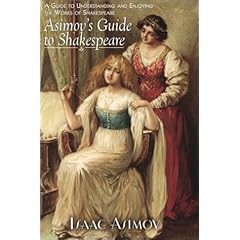This blog contains something related to Literature such as drama, novel, literary research, film
Monday, October 20, 2008
Asimov's Guide to Shakespeare: A Guide to Understanding and Enjoying the Works of Shakespeare
Shakespeare's genius is marked by his rare ability to appeal to theatergoers of all types and all levels of education. But for most modern folks, the Greek and Roman mythology and history, let alone the history of England and the geography of sixteenth-century Europe that his works are laden with, are hardly within our grasp. Isaac Asimov comes to making obscure issues clear to the layperson, selects key passages from 38 of the great bard's plays plus two of his narrative poems and, with the help of beautifully rendered maps an figures, illuminates us about their historical and mythological background.
While watching or reading one of Shakespeare's plays, it's interesting to read the notes of some of the different critics. Peter Levi does a wonderful job following the poetry and language of Shakespeare as it develops over his lifetime, in the context of the other writers of his era. Harold Bloom, of course, finds in Shakespeare both a mirror and an impulse for a leap forward in literature and therefore in society. Bloom has fallen in love with certain of Shakespeare's characters (Falstaff, Hamlet, etc.) and uses them as a yardstick for all others.
Asimov takes a more historical view. He has done impressive research into the characters and times. His "Guide to Shakespeare" is useful for its insights into all of the plays, but I found it most useful for the English histories. In the eight plays of the Wars of the Roses --from Richard II, through the Henrys, and culminating in Richard III-- Asimov tracks the family trees and politics of the nobility, spots anachronisms, and does a wonderful job of simplifying the sometimes bewildering array of characters and historical references. Of course, even uneducated audiences in Shakespeare's day would have understood some of these arcane references without a guidebook, much as a modern US audience would easily understand references to Thomas Jefferson or Abraham Lincoln. With his research and clear writing, Asimov brings the history plays --and indeed all of the plays-- back to life.
Subscribe to:
Post Comments (Atom)

No comments:
Post a Comment